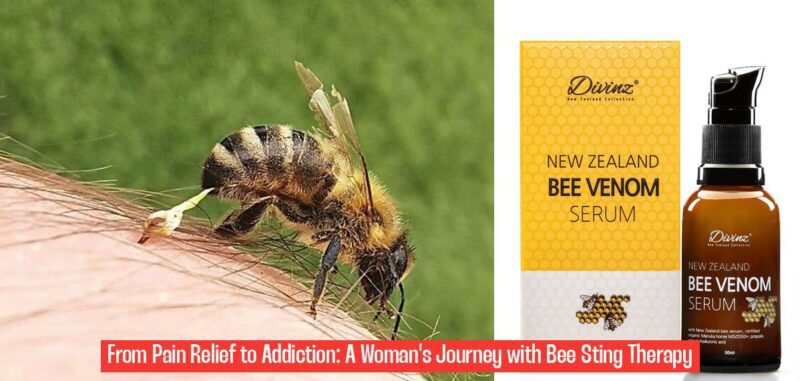The Allure of the Sting: One Woman’s Journey from Pain Relief to Bee Venom Addiction
Chronic pain can be a relentless and debilitating foe. The relentless ache and stiffness, the constant need for pain relievers, and the frustration of limited mobility can take a toll on both physical and mental well-being. It’s no wonder that those who suffer from chronic pain are willing to try just about anything to find relief. But what do you think about stinging yourself with bees?
Margaret, a woman from Morningview, Kentucky, found herself grappling with the debilitating effects of arthritis. The pain was so severe that it hindered her ability to move freely and complete daily tasks. Desperate for relief, she stumbled upon a peculiar solution: bee venom. Margaret believed that bee venom held the key to easing her pain, improving her mood, and even boosting her sex drive.
In an episode of TLC’s “My Strange Addiction” in 2013, Margaret recounted her journey, revealing that she first began stinging herself with bees after discovering that it seemed to ease her pain. She initially used only a few stings per day, but as the relief she experienced grew, so did the number of stings. Within a decade, Margaret had escalated her bee stinging ritual to a staggering 100 stings per week. She would sting herself on her hips, elbows, fingers, ankles, forehead, and even the tip of her nose.
The initial medical motivation for using bee venom quickly transformed into a full-blown addiction for Margaret. She carried bees in her purse, readily available for a quick sting whenever she felt the urge. The sensation, as she described it, was a “peppery burn” that led to a feeling of well-being. The initial sting was followed by swelling and itching, but Margaret believed that the benefits outweighed the discomfort.
Margaret’s husband, J.D., watched with growing concern as his wife’s reliance on bee stings escalated from one a day to a staggering 15 a day. He worried about the potential health risks associated with her practice and sought professional advice.
The Risks of Bee Venom Addiction
Dr. Dain Wahl, a medical professional who appeared on “My Strange Addiction,” expressed serious concerns about Margaret’s bee stinging habits. He emphasized the potential risks, including the possibility of a fatal allergic reaction. Although Margaret wasn’t allergic to bee venom at the time, Dr. Wahl pointed out that allergies can develop over time. He also warned that the exact amount of bee venom that could be considered toxic was unknown, making her practice inherently dangerous.
The potential for allergic reactions is a significant concern for those considering bee venom therapy. A single bee sting can trigger a range of reactions, from mild swelling and itching to severe anaphylaxis, a life-threatening condition. While some individuals may be able to tolerate bee stings without any adverse effects, even those who are not initially allergic can develop an allergy over time.
Dr. Wahl strongly recommended that Margaret stop stinging herself with bees, but she remained unconvinced. She believed that the benefits she experienced outweighed the risks. She argued that she “seemed to thrive” on the bee stings and saw no reason to stop.
A Growing Trend: Exploring the World of Api Therapy
While bee venom therapy is not a widely accepted or recommended practice, Margaret is not alone in her fascination with the potential benefits of bee stings. Celebrities like Gwyneth Paltrow and Gerard Butler have openly discussed their own experiences with bee sting treatments.
Paltrow, a well-known advocate for alternative health practices, revealed in a 2016 interview with the New York Times that she had tried bee sting therapy, describing it as a “thousands-of-years-old treatment called apitherapy.” She claimed that it was used to reduce inflammation and scarring. Butler, known for his action-packed roles, recounted his own experience with bee sting therapy, which he sought to reduce inflammation caused by stunt work. However, his experience took a dangerous turn, resulting in hospitalization after being stung by 23 bees. He described feeling like his heart was about to explode and experiencing intense itching, as if he had ants crawling under his skin.
Despite the anecdotal accounts of celebrities, researchers caution against the use of bee sting therapy, emphasizing that it is unsafe and unadvisable. The risks of allergic reactions, infections, and potentially fatal consequences far outweigh any potential benefits.
Bee Sting Therapy: A Controversial Approach with Limited Scientific Evidence
Bee venom therapy, also known as apitherapy, is a traditional medicine practice that involves the use of bee venom for therapeutic purposes. The practice dates back centuries, with proponents claiming that bee venom can provide relief for a wide range of ailments, including arthritis, multiple sclerosis, and even cancer.
While bee venom does contain certain compounds that have anti-inflammatory and pain-relieving properties, the scientific evidence supporting its effectiveness for these conditions is limited and inconclusive. Most of the research on bee venom therapy has been conducted in small, low-quality studies with limited methodological rigor.
Furthermore, the safety of bee venom therapy is a major concern. As mentioned earlier, bee stings can trigger allergic reactions, ranging from mild swelling to life-threatening anaphylaxis. The risk of allergic reactions is significant, especially for individuals with pre-existing allergies.
Exploring Safer Alternatives for Pain Relief
If you are struggling with chronic pain, it is important to seek professional medical advice. A qualified healthcare provider can help you develop a safe and effective treatment plan that addresses your specific needs and medical history. There are many proven and safe options for pain management, including medication, physical therapy, and lifestyle modifications.
It is crucial to avoid self-treating with bee venom therapy or any other unproven remedies. The potential risks outweigh any potential benefits. If you are considering bee venom therapy, it is essential to consult with a healthcare professional who specializes in alternative therapies. They can assess your individual risks and benefits and guide you toward safer and more effective treatment options.
Conclusion: Balancing Hope and Caution
The story of Margaret highlights the desperate search for relief that can accompany chronic pain. Her journey underscores the allure of unconventional treatments, even when those treatments pose significant risks. While it is important to be open to exploring alternative therapies, it is equally crucial to do so with caution and a critical eye.
Always consult with a qualified healthcare professional before starting any new treatment, especially if it involves potentially harmful substances like bee venom. Remember, there are safe and effective options for pain management, and there is no need to risk your health in pursuit of relief.
What led Margaret to start using bee stings for pain relief?
Margaret started using bee stings to relieve the severe pain caused by arthritis.
How did Margaret’s bee stinging ritual evolve over time?
Over time, Margaret escalated her bee stinging ritual to 100 stings per week on various parts of her body.
What concerns did Margaret’s husband have about her bee stinging addiction?
Margaret’s husband, J.D., was concerned about the health risks associated with her escalating bee stinging habit, which grew from one sting a day to 15 stings a day.
What risks did Dr. Dain Wahl highlight regarding Margaret’s bee venom addiction?
Dr. Dain Wahl expressed concerns about the potential risks of a fatal allergic reaction and other health complications associated with Margaret’s bee venom addiction.


